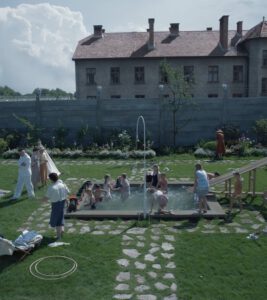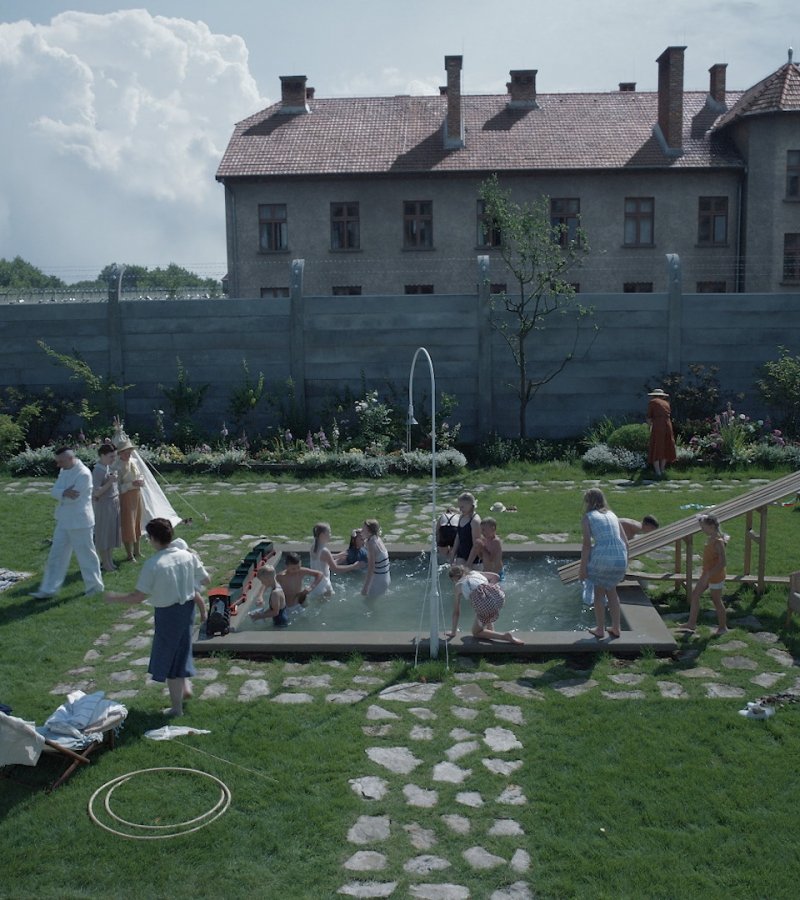Movie Info
Movie Info
- Director
- Jonathan Glazer
- Run Time
- 1 hour and 45 minutes
- Rating
- PG-13
VP Content Ratings
- Violence
- 0/10
- Language
- 0/10
- Sex & Nudity
- 1/10
- Star Rating
Relevant Quotes
Treasures gained by wickedness do not profit, but righteousness delivers from death.
For what is a man profited, if he shall gain the whole world, and lose his own soul? or what shall a man give in exchange for his soul?

Even had I known nothing about this film, other than it was set at Auschwitz during the Holocaust, I would know as soon as the title appeared on the dark screen that this would be an unusual film. The title stayed on for an unusually long time, and then consumed considerable time as the white letters slowly faded away to black. The screen remained black for so long that I looked at my watch and determined that it was at last two or three minutes. Well, not totally black. Almost imperceptibly there appeared a faint whiff of smoke. Or, because it was white–was it ashes? Accompanying this faint visual is Mica Levi’ unsettling music. As one whiff disappeared, others appeared, drifting across the screen. Then at last we are shown, of all things, a family picnic, with many adults and children in bathing suits. The main party are in a meadow, and below them in a gently flowing river are others enjoying its water.
Director/writer Jonathan Glazer has masterfully adapted Martin Amis’s 2014 novel about Rudolf Höss (Christian Friedel) and his wife Hedwig (Sandra Hüller) who live with their five children in a stately house next to the wall of Auschwitz. Amis and Glazer know that we have seen numerous Holocaust films in which we have seen Nazis brutally torture and execute Jews, singly and en masse. Thus, although we see the wall of the camp, topped with barbed wire, a guard tower, and dark smoke rising from tall smokestacks, we never are shown the horrific activities taking place on the other side of the wall. The cameras stay on this side of the wall to record the mundane activities of the camp’s Commandant and his family. Each morning Rudolph mounts his horse to make the short commute to his office.
We do see an occasional Jewish prisoner. One takes care of the plants around the house and garden. Another is pushing a wheelbarrow loaded with food or items taken from the murdered prisoners. In one case, the latter include a bundle of female underwear that Hedwig invites her friends to divide among themselves. In another scene she stands alone in her bedroom trying on a long fur coat. She could be looking at herself in a mirror at Macy’s as she gages how she looks. Neither she nor the other the women seem to think that anything is amiss, that their rightful owners are now dead, their bodies disposed of in one of the huge crematoriums that make the camp a literal factory of death. Hedwig orders her inmate servant girls around, sometimes ignoring them as if they were furniture. When she becomes infuriated by one, she rages against her, telling her she might scatter her ashes across a field.
That the camp is a death factory is driven home by a scene in which Rudolph sits with an engineer going over the plans for an additional crematorium. Each step of the mass murder routine has been carefully worked out, with the calculation that 500 bodies an hour can be turned to ashes. The engineer is proud of the design of the furnaces, so efficient because the two chambers of them are constructed so that neither need ever be shut down.
Hedwig proudly shows off her home and large garden to her visiting mother. She points to the various vegatables and colorful flowers she is growing, pointing out how many improvements she has instigated. Close-ups of the beautiful flowers make us aware of the ugliness on the other side of the tall wall. The camera zooms in so close on a red flower that all we see is a red screen, another reminder, this time of the bloodshed unfolding in the camp—to which she never seems to give a thought. Telling her mother that she has been dubbed “The Queen of Auschwitz,” she is clearly living the German equivalent of the American Dream—big house, gorgeous garden, and community prestige and power. In fact, so much so that when Rudolph is given a promotion that requires him to move to another area, she refuses to leave. At her urging he secures permission for the family to stay put. In his distant post he enjoys his increased authority and the palatial surroundings at an evening event, but he experiences them alone.
We do not see the horrors inside the camp, but we certainly hear them. The sound design by Johnie Burns becomes as important as the cameras—barking dogs, screams, occasional gun shots, the far-off rumble of a furnace, a crack of a whip, and a wail of a steam engine bringing in another shipment of victims. Litle wonder that Burns’ name is on the Oscar list for best Sound. Mixed with the haunting music by Mica Levi, it stokes the imagination to conjure up the horrors that the characters have schooled themselves to ignore.
At night, one of the Höss boys sits in bed playing with a collection of gold teeth, We wonder how he came by these grisly remnants of their owners. It must have been his father’s gift—what kind of a father would bring home such trophies to his children? That same night his sister sits by herself at a window and stares at the distant orange glow of the crematoriums. Was she curious at all about the origin, or have any ethical qualms?
This movie has evoked in about everyone who has seen it the phrase “the banality of evil,” which was coined by Hannah Arendt after watching Adolf Eichmann at his trial in Israel back in the 1960s. He was not the Nazi monster depicted in cartoons, but just an ordinary-looking man, an adjective that also applies to the members of the Höss family. Evil in our fantasy wears horns and sports a forked tale. These people are like you and me —they eat and play together; Poppa reads bedtime stories to his younger children. They cavort in their backyard, the children laughing as they slide down the planks into their small swimming pool. How easily they, young and old, seem to compartmentalize in their minds the horrors they hear daily from their middle-class daily pursuits.
A puzzling feature at first is a series of recurring sequences shot in night vision, giving a ghost-like look to them. We see a girl hiding apples at places where the Jewish captives would be passing by or working at. I had no idea how this fit in until I read an interview in which Glazer reveals that the girl is based on a real person whom he had met when she was an old woman. He had learned that she had hidden fruit where the Jews would find it. “That small act of resistance, the simple, almost holy act of leaving food, is crucial because it is the one point of light,” he says. “I really thought I couldn’t make the film at that point. I kept ringing my producer, Jim, and saying: ‘I’m getting out. I can’t do this. It’s just too dark.’ It felt impossible to just show the utter darkness, so I was looking for the light somewhere and I found it in her. She is the force for good.” Can you hear the faint strains of “This Little Light of Mine”?
Glazer’s is an important film, both because of its subject and because of the unusual way the filmmaker treats what might be the greatest evil ever committed by humans against their fellow human beings. We live at a time when antisemitism and racism are finding large numbers of people, including politicians, willing to subscribe to their twisted lies. I hope the film does well at the Oscars—had I been able to see it sooner, it would have been included on VP’s Top Ten Films list! Be sure to check it out and see why it won the Grand Prix at this year’s Cannes Film Festival and the year’s Best Picture at the Los Angeles Film Critics Assn.—and why so many critics have called it a “masterpiece.”
This review will be in the March issue of VP along with a set of questions for reflection and/or discussion. If you have found reviews on this site helpful, please consider purchasing a subscription or individual issue in The Store.

